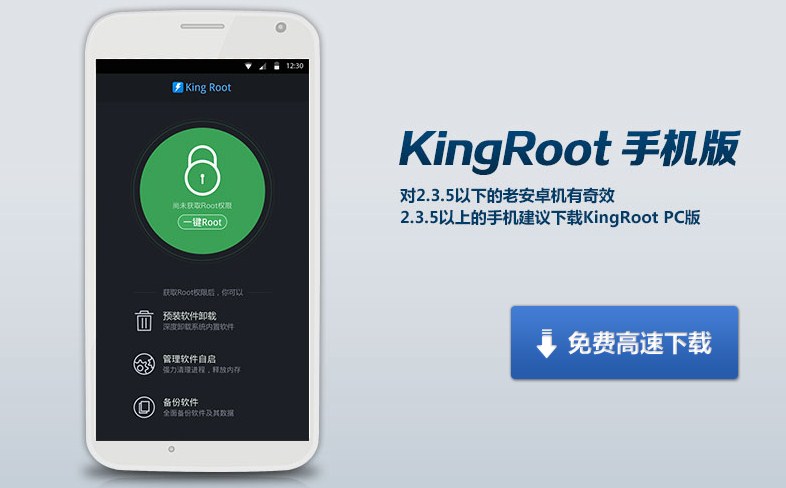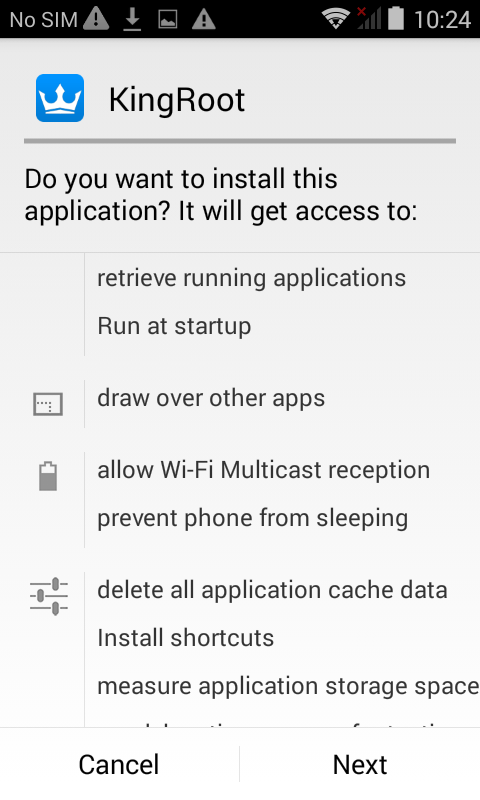“Okay, here is an article about KingRoot APK, aiming for approximately 1600 words, covering its features, benefits, risks, and alternatives.
Okay, here is an article about KingRoot APK, aiming for approximately 1600 words, covering its features, benefits, risks, and alternatives.

Unlocking Your Android’s Potential: A Deep Dive into KingRoot APK
Android, the world’s most popular mobile operating system, is known for its flexibility and open nature. However, even with its inherent customizability, manufacturers and carriers often impose limitations, restricting users from accessing the deepest levels of the system. This is where "rooting" comes in – the process of gaining privileged control (superuser access) over your Android device. Rooting opens up a world of possibilities, from removing unwanted bloatware and installing powerful root-only apps to flashing custom ROMs and kernels that can dramatically alter your device’s performance and appearance.
For many years, rooting was a complex process, often requiring specific technical knowledge, command-line interfaces, and device-specific exploits. This complexity was a barrier for average users who wanted the benefits of root access without the steep learning curve. This demand for simpler solutions led to the rise of one-click rooting tools, and among the most popular, and perhaps most controversial, is KingRoot.
KingRoot is an application, primarily distributed as an APK file (Android Package Kit), designed to root a wide range of Android devices with minimal user interaction – often, as its marketing suggests, with just "one click." Its promise of simplicity and broad compatibility made it incredibly appealing to users seeking an easy path to root access. However, this ease of use comes with significant caveats and potential risks that every prospective user must understand before proceeding.
This article will delve deep into KingRoot APK: what it is, how it works, its perceived benefits, the step-by-step process of using it, and, critically, the substantial risks and controversies surrounding its use. We will also explore safer alternatives that have gained prominence in the Android rooting community.
What is KingRoot APK?
KingRoot is a rooting utility developed by a Chinese company. Unlike rooting methods that require a computer connection and specific drivers, KingRoot is often available as a standalone Android application (APK) that you download and install directly on your device. It works by identifying and exploiting system vulnerabilities specific to your device’s model and Android version to gain root privileges.
The core appeal of KingRoot lies in its simplicity. Once installed, the user typically opens the app, taps a prominent "Root" button, and the application attempts to find a suitable exploit from its extensive database. If successful, the device is rooted, and a superuser management tool (often KingUser, though sometimes it might install KingoUser or others) is installed to manage root permissions for other apps.
KingRoot gained popularity because it supported a vast number of devices and Android versions, including many less common models that might not have had dedicated rooting guides or tools available. For users struggling to find a rooting method for their specific phone or tablet, KingRoot often presented itself as a viable, and easy, solution.

Why Do People Choose KingRoot? The Allure of Simplicity
The primary reasons users turn to KingRoot are:
- Ease of Use: The "one-click" nature is its biggest selling point. It removes the technical hurdles associated with other methods.
- Wide Device Compatibility: KingRoot boasts support for a large number of devices from various manufacturers and across different Android versions. This broad compatibility made it a go-to option when device-specific methods were unavailable or difficult to follow.
- No PC Required (Often): While a PC version exists, the ability to root directly from the device using the APK is a major convenience.
- Free of Charge: KingRoot is available for free, making it accessible to anyone.

These factors combined to make KingRoot a popular choice, particularly for users who were new to rooting or who had devices that weren’t mainstream.
How to Use KingRoot APK: A General Guide (with Crucial Warnings)

While the process is designed to be simple, it’s imperative to follow steps carefully and understand the risks involved.
Disclaimer: Proceeding with rooting, especially using tools like KingRoot, can void your device’s warranty, potentially brick your device (make it unusable), and introduce security risks. This guide is for informational purposes only. The author and publisher are not responsible for any damage or issues that may arise from attempting to root your device.
Before You Start:
- Backup Your Data: This is CRITICAL. Rooting can sometimes lead to data loss or require a factory reset. Back up everything important – photos, videos, contacts, apps, etc.
- Charge Your Device: Ensure your device has at least 80% battery life, preferably 100%. Rooting can take time, and running out of power during the process can lead to bricking.
- Enable Unknown Sources: Go to your device’s Security settings and enable the option to install apps from "Unknown Sources." This is necessary because you are installing an app from outside the Google Play Store.
- Ensure Internet Connection: KingRoot needs internet access to download necessary files and exploits.
- Disable Antivirus/Security Apps: Sometimes, security apps can interfere with the rooting process or flag KingRoot components as malicious (which, as we’ll discuss, is a complex issue). Temporarily disabling them might be necessary, but re-enable them afterward.
Step-by-Step Process:
- Download the KingRoot APK: Obtain the latest version of the KingRoot APK from a trusted source. Finding a truly "trusted" source for KingRoot can be difficult due to its nature and distribution methods. Be extremely cautious about where you download it from.
- Install the APK: Locate the downloaded APK file using a file manager and tap on it to install. You might receive warnings about installing from unknown sources; proceed if you have enabled the setting.
- Launch KingRoot: Open the KingRoot application after installation.
- Check Root Status: The app will usually check if your device is already rooted. If not, it will indicate that rooting is possible.
- Tap "Try To Root" or "Start Root": Tap the prominent button to begin the rooting process.
- Wait: KingRoot will now attempt to find and apply an exploit for your device. This process can take several minutes. Do not interrupt it. Your device might reboot during this process – this is often normal.
- Completion: If successful, KingRoot will notify you that the device has been successfully rooted. It will likely install its own superuser management app (like KingUser).
- Reboot Your Device: It’s often recommended to reboot your device after the process is complete.
- Verify Root: You can download a "Root Checker" app from the Google Play Store to confirm that your device has root access.
If the process fails, KingRoot might suggest trying again or using the PC version. Repeated failures might indicate that your device or Android version is not supported by the current version of KingRoot.
The Benefits of Rooting (and Using KingRoot to Get There)
Assuming KingRoot successfully grants root access, you unlock the full potential of your Android device. The benefits include:
- Complete System Control: Gain read and write access to system files and directories.
- Remove Bloatware: Uninstall pre-installed system apps that you don’t use, freeing up storage space and potentially improving performance and battery life.
- Install Root-Only Apps: Access powerful applications that require root permissions, such as:
- Ad Blockers (like AdAway): Block ads system-wide, including in apps and browsers.
- Firewalls (like AFWall+): Control network access for individual apps.
- Backup Tools (like Titanium Backup): Back up apps and their data, including system apps.
- Automation Tools (like Tasker with root plugins): Perform complex automated tasks.
- System Tweakers: Modify system settings not normally accessible (e.g., CPU governors, build.prop edits).
- Install Custom ROMs and Kernels: Replace your device’s entire operating system with a custom version (like LineageOS, Pixel Experience) or install a custom kernel for better performance, battery life, or features. Note: While KingRoot provides root, flashing custom ROMs/kernels usually requires unlocking the bootloader and using a custom recovery like TWRP, which is a separate, often more complex process than just rooting.
- Improve Performance and Battery Life: By removing bloatware, freezing apps, and using root-level tweaking tools, you can potentially optimize your device’s performance and battery consumption.
- Full Device Backup: Create complete NANDroid backups of your entire system using a custom recovery.
KingRoot’s specific benefit in achieving these is its ease of access for users who might otherwise be intimidated by more technical methods.
The Significant Risks and Controversies Surrounding KingRoot
While the benefits of rooting are clear, the risks associated with using KingRoot specifically are substantial and have led many in the Android community to advise against it. These risks fall into several categories:
- Security Concerns: This is the most significant issue.
- Closed Source: KingRoot is proprietary and closed source. This means no one outside the development team can inspect its code to see exactly what it does. This lack of transparency is a major red flag, especially for an application that gains the highest level of system access.
- Potential for Malware/Spyware: Due to its closed-source nature and origin, there have been persistent reports and concerns within the security community that KingRoot could bundle unwanted software, collect sensitive user data without explicit consent, or even act maliciously
